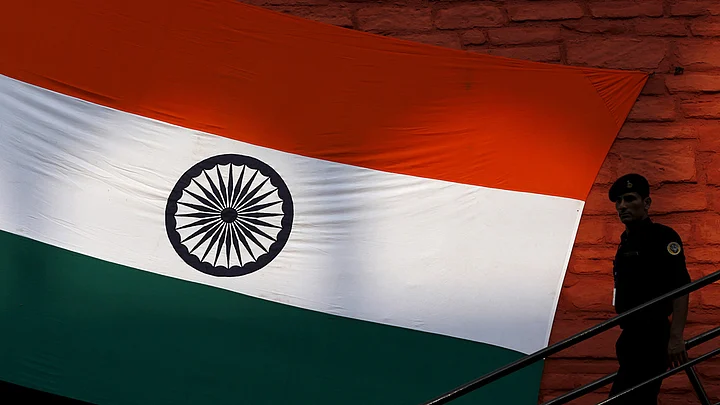For many of us, the singing of our National Anthem has come to signify a hollow ritual, a token genuflection to the idea of India without really listening for the meaning behind the music. Today, on the 104th anniversary of the song’s first public airing, it is probably time to reconsider what this anthem signifies for us.
Rabindranath Tagore had composed Jana gana mana adhinayaka jaya hey on 11 December 1911. Asked to compose a song for the Coronation Durbar of George V, Rabindranath had instead created what he would later describe as a tribute, not to the British monarch, but to the divine Maker of Bharatvarsha’s destiny, a power far greater than any mortal king. It was published in the Brahmo Samaj journal called Tatva Bodha Prakasika, but performed in public later, at a convention of the Indian National Congress in Kolkata on 27 December 1911. Years afterwards, the song’s first stanza would be adopted as the National Anthem of independent India.
The Fault in Our Anthem
It is only too easy to find fault with our anthem. In fact, it has always been dogged by controversy. Some mistake it for a paean to George V and accuse Rabindranath of being an imperialist stooge. Others complain that it does not reflect the geographic contours of independent India, demanding that “Sind” be replaced by “Kashmir”. Others protest that most Indians can’t relate to the lyrics because the Sanskritised language sounds unfamiliar and remote.
Yet these charges have also been rebutted with fervour by champions of the song. In a letter to P.B. Sen dated 10 November 1937, Tagore himself splutters: “That Lord of Destiny, that Reader of the Collective Mind of India, that Perennial Guide could never be George V, George VI, or any other George”. The song’s lyrics have enthused generations of Indians, and inspired Ananda Samarakoon to compose the Sri Lankan national anthem along recognisably similar lines. Always controversial, Jana gana mana still persists in the public imagination.
So what is so special about Jana gana mana? What accounts for its power to move us, and what can it mean to us today? For one thing, it is a song that celebrates diversity. Tagore’s idea of nationhood is not premised on conformity to a single norm. “To come under one master, one law, is dangerous for freedom,” he declares. In a country now riven by debates on intolerance and freedom of expression, his words give us food for reflection.
The Anthem Celebrates a Newly Formed Nation’s Aspirations
The anthem uses lists or catalogues, naming states/regions, religions, rivers, mountain ranges – all different, yet rising above their differences to express their sense of a common destiny, and the aspirations of a nation in the making:
Punjab-Sindhu-Gujarata-Maratha
Dravida-Utkala-Banga
Vindhya-Himachala-Yamuna-Ganga
Uchchhala-jaladhi taranga
This integrative impulse produces an extraordinary synergy, born of the interdependency of all the elements that go into the making of Bharatvarsha. Its dynamism springs from the harmony of human and natural worlds, conjuring up a dramatic vision of rivers, sea-waves and mountain ranges that arise in unison with the people of the land to serenade Bharata bhagya vidhata. Today, as we confront the threat of climate change on an endangered planet, the words of Tagore’s song acquire an even more urgent resonance.
A Synergetic Experience
Synergy here functions as a creative force. It does not speak of blood, destruction, military heroism and violence. Tagore’s music is not tinged with the blood that colours many other national anthems. It does not glorify hatred and violence in the name of a one-sided nationalism defined by any single religion, race or creed.
Tagore, initially a leading figure in the Swadeshi movement sparked by the first Partition of Bengal in 1905, later withdrew from direct participation in the nationalist movement as it took on violent and communal overtones, and instead expressed his political views mostly through his creative and philosophical writings. Shortly before the composition of Jana gana mana, he had also published his monumental novel Gora (1910), where the central character, at first a militant Hindu nationalist, finally becomes a true citizen of Bharatvarsha only when he sheds the trappings of religion, caste and race that had previously given him a false sense of identity.
The Song of “Real Things”
This ideal of nationhood, implicit in the term Bharatvarsha, goes beyond the European model of the nation-state. In the 1902 essay Nation Ki? (“What is a Nation?”) Tagore argues that the true nation “is a live entity, a psychological substance” that transcends the limits of race, religion, territory and political leadership. Two elements form the essence of Tagore’s ideal nation: “the ancient, treasured memory of the general public” and “the desire for mutual consent and collective co-existence”. In this idea of nationhood, the human heart has a place beyond the European ideal of reason: “to suffer together, rejoice together, live together in hope – these are the real things”. That special synergy gives our anthem its living, emotive, inspirational power.
(Radha Chakravarty is a writer, critic and translator.)
(At The Quint, we question everything. Play an active role in shaping our journalism by becoming a member today.)
